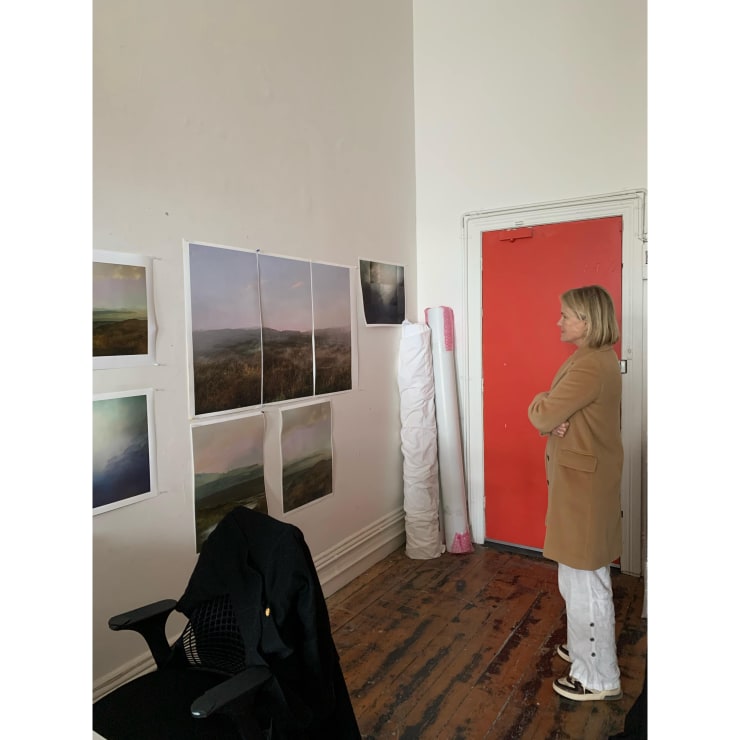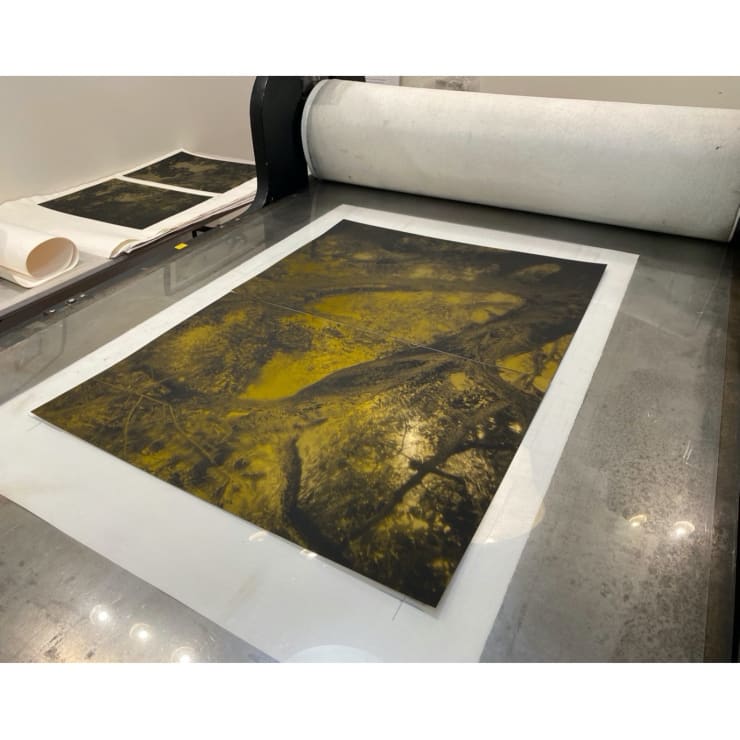Ahead of her solo show at Otomys entitled, Vast and Intimate, the Otomys team joined Sophia Szilagyi in her Fitzroy studio in Melbourne to discuss her residency at The Baldessin Studio in St Andrews, Victoria. Originally created by acclaimed Australian sculptor and printmaker George Baldessin in 1977, The Baldessin Press and Studio was reopened in 2001 by the artist's wife. The studio operates in George’s memory, connecting artists with traditional and contemporary printmaking techniques and methods.
During our visit Sophia delighted us with two bodies of work; a series of traditionally printed photogravure plates completed during her residency, and a collection of digitally printed works created in her Fitzroy studio. Sophia aptly entitled her Baldessin works the ‘Wandering series’ – a name truly evocative of the visual journeys that Sophia creates.
Despite employing two different techniques, there is a powerful connection between the two collections; soft shades of blues and luminescent violets created a mood that we have not really experienced with Sophia’s work before. These ethereal colours contrast against the rich darkness of shadowy grassland and tall trees, creating a sense of nostalgia and longing within Sophia’s landscapes. Not only does Sophia converge and manipulate a variety of different personal images, colours, and forms to create her landscapes, she also calls upon different memories and emotions to create places of what has been described as ‘emotion-scapes’.
We sat down with Sophia to discuss her time at The Baldessin Studio and the extraordinary fine art limited edition prints she has recently produced.
OTOMYS: Your landscapes seem so familiar yet otherworldly. What is the main source of these images?
Sophia Szilagyi: The landscapes within this digitally printed series largely use images that were taken at Sorrento. There is also a moonlight image, which was taken during a trip to Finland, in a lot of these works, which is why the stream has this silver glow – it’s from the moon reflecting on the water. Lockdown has been a time of isolation and at times, extreme quiet and stillness. I have tried to capture these qualities within these landscapes.
I start with a literal place that I have visited and focus on the sensations I experienced whilst there. I remember how it felt to be there and try to instil these sensations and feelings within the image, building my landscape around these experiences. It is not just about what emotions and memories the place conjures; it is about the physical experience of the landscape. I focus on the smells, the wind, the temperature, the mood, taking thousands of photos that attempt to document these intangible experiences. What I then create in the studio is a subjective impression of that geography. Sometimes I will also integrate images from other locations, which accentuates the role of memories and sensory experiences in shaping our impressions of the land.
The etchings I have created during my time at Baldessin, however, use sources from my Botanical series. Here I have reframed them and zoomed in on sections and gone back and re-presented them from a new perspective. I often re-use images from different works or from a long time ago, as I have done here. This comes back to the idea of memories and their role in shaping and creating new images and places to inhabit. When I use images from the past, I am reminded of old times and feelings that inform how I create a landscape. But, memory blurs and slips, it is not finite. I gather fragments of a feeling or sensation just as I collate visual imagery.
OTOMYS: Tell us about the printing process you use at Baledessin.
Sophia Szilagyi: The technique I used at Baldessin was photogravuer with chine colle or pigment colour. Simply put, creating a photogravure involves using a photograph or negative to etch an image into a copper plate with light and chemicals, then printing it traditionally with ink on paper. So technically, it is a mechanically produced print. Chine colle is a technique, used in conjunction with printmaking processes such as etching, that results in a two-layered paper support: a tissue-thin paper, cut to the size of the printing plate, and a larger, thicker support paper below.
OTOMYS: Is this a fast process?
Sophia Szilagyi: Making the plates is time consuming and then so is inking them up and taking them through the press. The presses themselves are so heavy that it is impossible to print anything too fast. Even though there are three in an edition, each edition will vary slightly as they are made by hand.
OTOMYS: So, they really are originals in many ways.
OTOMYS: Once you have completed your edition you hold onto the copper plate?
Sophia Szilagyi: No, usually you destroy it. I used to work for a traditional printing press and once we had run the edition, we would get a knife…and sayonara. We do this so people cannot print from it.
OTOMYS: Do different places evoke different moods for you?
Sophia Szilagyi: I begin by consciously choosing the location I wish to represent. I remember how it felt to be there, I try to express these feelings or thoughts into the portrayal of that landscape. From there I let the work carry me where it needs to go.
OTOMYS: In these new works we can see a shift in your use of light. Your use of soft blues, violets and the distinct golden hue of your prints is striking. Is there any meaning behind this shift?
Sophia Szilagyi: I think as an artist sometimes you set challenges for yourself to explore new things. It’s interesting because I haven’t really thought much of this change, but these colours do stretch over two different suites of work and two different mediums. Even so, the works within the Wandering series still incorporate a lot of darkness and a lot of shadow. But people forget that darkness plays a huge role in creating and framing this lightness. There cannot be light without shadow.
OTOMYS: I think it’s interesting how you conceptualise lightness and darkness and how this compares to the mainstream understanding of light and dark. We instantly assume that darkness must have negative or emotionally dark connotations.
Sophia Szilagyi: That’s right. As you know I was trained as a print maker, so I have always been drawn to the quality and beauty of a true printers black. It is like velvet, it’s the most amazing colour. I was also heavily influenced by black and white films and have always been attracted to the shadows and use of black here. I am drawn to the mystery of darkness. I think it acts as a place where we can rekindle with memories, where we can escape into something.
Vast and Intimate will be on display at Otomys from 23 March until 6 April 2023. To regiester your interest in Sophia's upcoming exhibtion please contact us at info@otomys.com.
November 14, 2022



